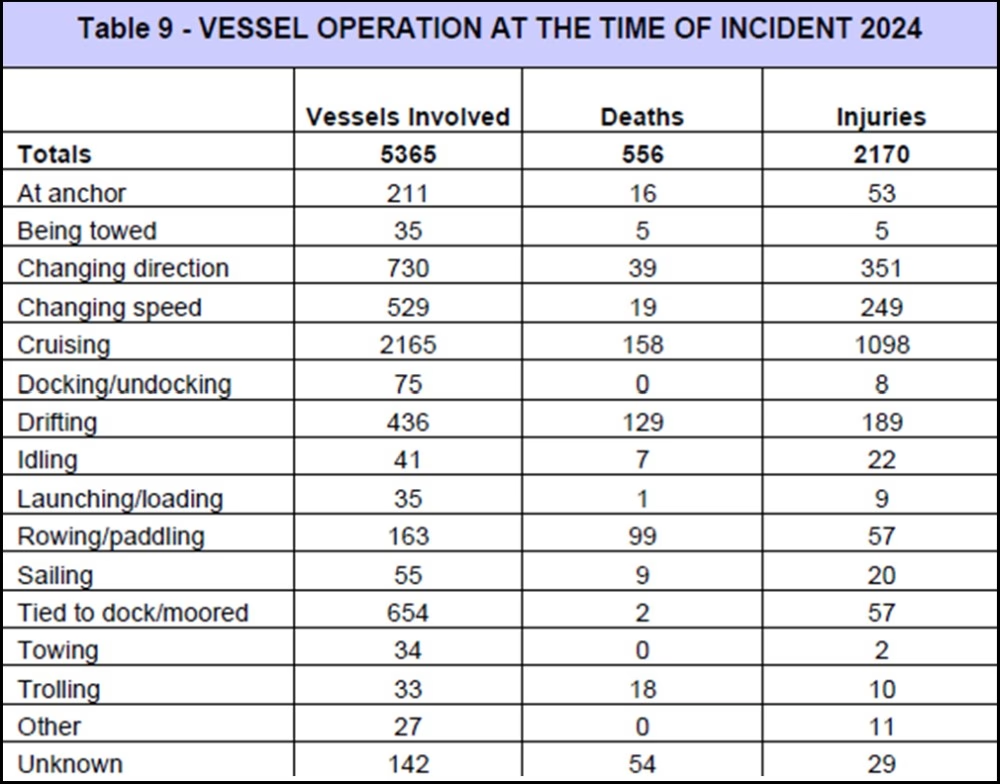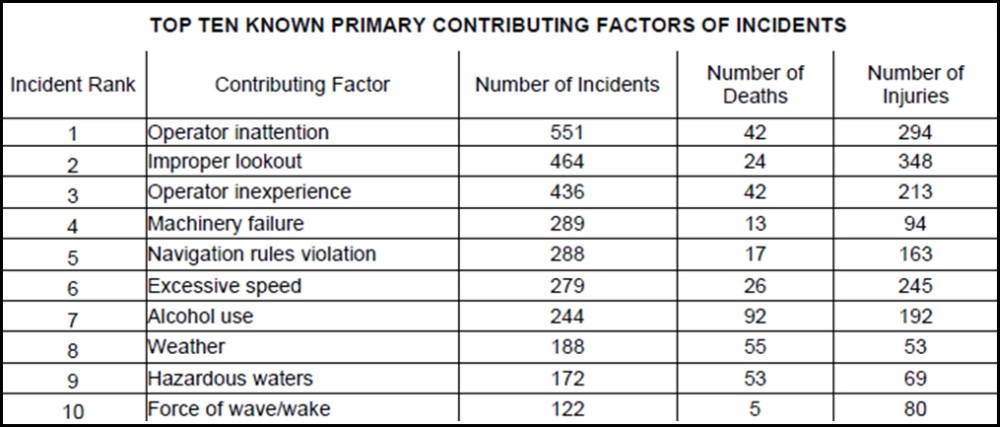
Recreational Boating Statistics
Whenever you get the phone call from one of your children that they have been involved in a car wreck, you first ask if they are okay and then ask what they were doing when they had the accident. Well, the Coast Guard does the same thing. Federal law requires the operator or owner of a recreational vessel to file a boating accident report with the State reporting authority if the recreational vessel is involved in an accident that results in any of the following:
- A person dies
- A person is injured and requires medical treatment beyond first aid
- A person disappears from the vessel under circumstances that indicate death or injury
- Damage to vessels and other property totals $2,000 (lower amounts in some states and territories).
- The boat is destroyed.
Report Timelines:
- Within 48 hours if a person dies within 24 hours, is injured and requires medical treatment beyond first aid, or disappears from the vessel under circumstances that indicate death or injury.
- Within 10 days of the occurrence or death if earlier reporting is not required.
The information you provide is used to establish regulations and safety standards, identify and remedy boat defects, educate recreational boaters, capture statistical data, investigate accidents, and measure the effectiveness of boating safety programs.
Accident Reporting Forms
Forms may be found on the Coast Guard’s Directive and Publications Division Website at or entering the form numbers into a web search engine:
CG-3865 Recreational Boating Accident Report
CG-3865-SP Reporte Del Accidente En Barcos De Recreacion
Most states and territories accept this form, although some have their own.
A listing of contacts for the state’s primary boating authority may be found at https://www.nasbla.org/about-nasbla/boating-contacts. Reports are generally sent to the Boat Accident Report Database administrator.

The Coast Guard CG 3865 Recreational Boating Accident Report is 15 pages long and asks very specific questions about the accident, including questions about what you were doing at the time of the accident. The table above was created from those accident reports. A quick review of the table shows that the categories are simply listed in alphabetical order rather than by order of severity, so it takes some analysis to categorize this category by severity.

Using the two tables above together, we can see what was happening and assign some probable causes for the deaths and injuries in the top four categories. Each category can have multiple contributing factors. Note that the Contributing Factors table is in Incident Rank order.
1. Cruising: 158 Deaths/1098 Injuries
We would expect this category to have the most deaths and injuries. Most boats are of the cruising type, and cruising is one of the most popular boating activities. What contributing factors can make cruising a dangerous activity:
- Operator Inattention
- Improper Lookout
- Operator Inexperience
- Alcohol Use
Actually, all of the contributing factors cause death and injury in this category. As a recreational boater you can mitigate these contributing factors by banning alcohol use on your boat, removing distractions as you operate, having a passenger serve as a lookout, and by getting some experience and training such as taking a Safe Boater class.
2. Drifting: 129 Deaths/189 Injuries
Apparently drifting is almost as dangerous an activity as cruising. My guess is the boat operators become complacent and et down their guards. After all, why would you need a lookout if you are barely moving? From my own experience, while on a maritime observation patrol of the Texas City Dike, we observed three fishermen drift fishing just outside the Texas City Ship Channel. They were facing the dike and were oblivious to a loaded tanker bearing down on them at 10-12 knots. Horn blasts from the ship finally awakened them to the danger just before the ship ran them over. No need to a, b, c this one. It was pure operator inattention and improper lookout.
3. Rowing/Paddling: 99 Deaths/57 Injuries
Paddling incidents have been increasing for several years due to the low cost to purchase coupled with a severe lack of training. Operator inexperience is the key to the severity of this category. Unlike most powerboat operators who are required to take a Boater Safety Class if they were born after August 31, 1993, kayak and paddle board operators are not required to have any boater safety education, nor are they required to wear a life jacket.
4. Changing Direction: 39 Deaths/351 Injuries
When is the last time you looked in your boat’s rear view mirror before you made a heading change with your boat? What? You don’t have rear view mirrors? I always wondered why most boats had no rear-view mirrors. If you have ever owned a boat and operated it near other boats, chances are you have had someone pass you just as you were about to make a U turn. You didn’t look before turning and you didn’t have a proper lookout. These types of incidents happen because of operator inattention, improper lookout, and maybe a little alcohol-induced complacency. This type of incident happens in marked channels where all traffic must stay in the channel or risk running aground. There is always someone in a hurry wanting to get around everyone. You see them. Just be sure they don’t pull out in from of you or be prepared in case they do.
Summary
Reviewing the Recreational Boating Incident report can help us identify our own bad behavior as well as the bad behavior of other boaters. Armed with the knowledge of how certain boating incidents occur, we can modify our own behavior to help us avoid certain types of incidents that occur as we are cruising, drifting, changing direction, or operating a paddlecraft. Be aware of the bad possibilities and adopt safe practices to avoid them.




